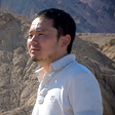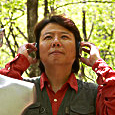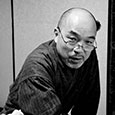
Ohtsuki Koukun 大月 光勲
A Noh mask artist living in Kyoto
Noh masks made by Ohtsuki Koukun
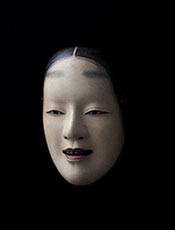
Waka-onnna
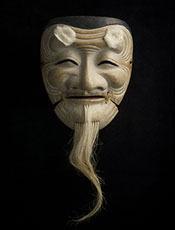
Okina
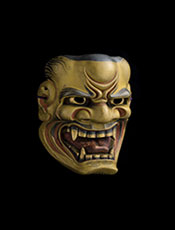
Shishi-guchi
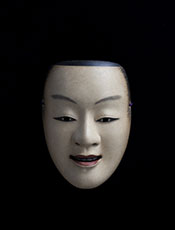
Atsumori
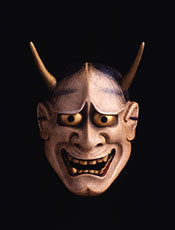
Han-nya
These masks are used in Noh, a type of art registered in the UNESCO Intangible Cultural Heritage List.
Noh masks have developed over more than six hundred years to have the maximum impact on the stage.
They also act as the souls of Noh actors, who are able to make them come alive onstage.
Ohtsuki says that while the Noh masks can be admired mounted on a wall; the masks are best seen in movement in the theater. At an exhibition on Paris he himself donned a mask to dance as Yoroboushi (a character in a Noh play), drawing much praise for the changing expressions created by his movement.
He has held exhibitions in locations such as Kyoto, Kamakura, Paris, and Portland.
He also regularly holds workshops in Kyoto, Kamakura, and Sagamihara, showing everyone from children to adults how to make their own Noh masks.
He held an exhibition called Mirrors of the Mind: The Noh Masks of Ohtsuki Koukun over two months from October 14 to December 3 in 2017, at the Portland Japanese Garden in Portland, Oregon.
Mirrors of the Mind: The Noh Masks of Ohtsuki Koukun
The exhibition displayed 30 masks and also genuine Noh costumes.
It aroused much interest in both Noh masks and the Japanese Garden, drawing in 1.5 times as many visitors as usual.
Raku Museum 40th Anniversary Special Exhibition- The wabi of Raku and the y?gen of Noh: the aesthetics of form in the Kamigyo Ward of Kyoto held over three months from March 17 to June 24, 2018.
Two of the masks on display were created by Ohtsuki Koukun.
A gallery talk was held by Kichizaemon Raku and Ohtsuki Koukun on May 3, 2018.
The Muromachi Period was one of the most pivotal periods in Japanese history, giving rise to unique forms and culture and aestheticism. The seat of the military government established in the Kamakura Period shifted to Kyoto, becoming infused with the culture of the court nobles and connected to spirituality such as Zen. This led to the rise of new arts of the samurai, such as the subtle yet profound Way of Tea that emphasized austere elegance. Though the genres were different in their expression, such as Noh and the Way of Tea, they shared a similar sense of aesthetics and influenced each other.
The Way of Tea incorporates many designs and inscriptions deriving from Noh songs and programs. Though it is no longer so common, in the past tea masters and guests would also enjoy singing Noh songs during the ceremony.
Noh has also greatly influenced the Raku teaware (hand-molded earthenware teacups) . A sense of beauty stripped of all inessentials is at the heart of the type of expression both Raku teaware and Noh masks seek to achieve. The presence commanded by the potter Chojiro’s Raku teaware in the compact, simply furnished tea-room is comparable to that of performers on the sparse set of the Noh stage. Many of the inscriptions on teaware in fact derive from Noh, while the shape of the Ryugo vases used in the tea ceremony are based on the drums used Noh.
This exhibition focuses on Noh and the tea ceremony, in particular on Noh masks and Raku teaware, to pursue through the works the shared sense of beauty, of the subtle and profound, that is found in both.
From the Raku Museum 40th Anniversary Special Exhibition-
Combined exhibitions like this bringing together Noh masks with other arts such as Japanese gardens or Raku teaware offers opportunities to reassess history and culture. In the future there will also be assorted collaboration-type exhibitions featuring Noh masks and contemporary digital culture, arts, the IoT and so on.
Ohtsuki also acts as an instructor for corporate training or general workshops, to teach the creation of Noh masks, as an opportunity to reconnect with the spirit of what it means to be Japanese.
At Trendy, we accept your work requests.
- Sale of Noh masks
- Creation of Noh masks
- Lectures on Noh masks incorporating Japanese history and culture (only in Japan)
- Visiting lessons on the creation of Noh masks (only in Japan)
- Corporate training and general workshops to learn Japanese culture and techniques through the creation of Noh masks (only in Japan)

BIOGRAPHY
| 2019 |
Instructor in the making of Noh masks for the open college of Kobe Women’s University and Kobe Women’s Junior College
Publication of NOH MASKS:FLOWERS IN THE MIRROR  |
|---|---|
| 2018 | Held the Held the Raku Museum 40th Anniversary Special Exhibition- The wabi of Raku and the yūgen of Noh: the aesthetics of form |
| 2017 | Mirrors of the Mind: The Noh Masks of Ohtsuki Koukun exhibition (Portland, Oregon (USA)) |
| 2016 | Held The World of yūgen Noh Masks of Ohtsuki Koukun exhibition at the Nishijin Orinasukan Museum |
| 2015 | Held the Kotohogi Noh Costumes and Masks exhibition at the Nishijin Orinasukan Museum
Held Noh mask lectures on Kunashir Island and Iturup Island as part of a cultural exchange visit to the Northern Territories Individual exhibition at the Espace Culturel Bertin Poirée in Paris, France (Association Culturelle Franco-Japonaise de TENRI) |
| 2014 | Founded the Kamakura Koukunkai
Individual exhibition at the Gallery Issuido in Kamakura Collaboration of Noh masks with the dolls of Kyugetsu, Development of Noh dolls |
| 2013 | Held Sal tree flower viewing and Noh masks exhibition at Fujito-ji Temple in Kurashiki city |
| 2012 | Dedicated the Atsumori Noh mask to Ikuta Shrine in Kobe; used in the play Atsumori (leading part Fujii Tokuzo) staged by torchlight: held individual exhibition to celebrate his 60th birthday at Kyukyodo in Ginza
Held individual exhibition at Daitoku-ji Temple and Obai-in Temple in Kyoto |
| 2011 | Created and dedicated a creative mask called Robai Komachi based on the Seated Stupa Komachi statue (made by Genshin in the Kamakura Period) in Zuishin-in Temple |
| 2010 | Copied the Waka-onna (Young Woman) mask made by Deme Hokan Mitsunao in the collection of the Umewaka Clan, with the permission of Umewaka Gensho |
| 2008 | Exhibited works in the Contemporary Noh and Kyogen Mask Artists exhibition held by the Waseda University Tsubouchi Memorial Theatre Museum |
| 2007 | Kodai-ji Temple special exhibition called Beauty of yūgen – Ohtsuki Koukun held in the Kitasho-in (May 11 ~ July 8)
Copied the mask Magojiro by Tokuwaku with the permission of the Head of the Kongo School, for the Noh play Dojoji, at the request of Ueda Kyozo (Kongo School) |
| 2005 | Held an event called The Beauty of Japan and the World of Masks with Matsuyama Takao (Noh mask artist of the Kanze School) at the library of Tohoku University of Art and Design. The event was organized by the university (Yamagata City) and planned by its Tohoku Cultural Center. It was part of the General Study of Japanese Culture as Part of Asia of the Open Research Center of the Ministry of Education, Culture, Sports, Science and Technology. |
| 2004 | Held the Second Shogetsu-no-kai Noh Mask exhibition (together with Komatsudani Kousyun ) at the Museum of Kyoto in May.
Exhibited two creative masks, Yokaze-oni (Night Wind Demon) and Yami-oni (Shadow Demon) created in response to the Saidofu-oni teacup of Kichizaemon Raku XVI for the special fall exhibition of the Raku Museum called The wabi of Raku and the yūgen of Noh: the aesthetics of form, and the masks became the possession of the Raku Museum. Created and performed with the creative masks Terute-hime and Oguri for the contemporary Noh play Terute on the 50th anniversary of Sagamihara City, at the request of Matsuyama Takao, and the masks became the possession of Sagamihara city. |
| 2003 | Held individual exhibition to commemorate 30 years of Noh mask making, at the Kurashiki City Art Museum |
| 2001 | Held the First Shogetsu-no-kai Noh Mask exhibition (together with Komatsudani Kousyun) at the Museum of Kyoto
Held individual exhibition to commemorate 30 years of Noh mask making, at Kyukyodo in Ginza |
| 1999 | Instructor in a course on the fascination of Noh masks at the Takatsuki City Lifelong Learning Center
Held individual exhibition at Sogo Department store in Hiroshima Held Koukun Noh Mask Association Tenth Anniversary Exhibition at the Museum of Kyoto Founds the Sagamihara Koukunkai |
| 1997 | Individual exhibition at the Museum of Kyoto |
| 1996 | Created a Ranryoo Bugaku mask at the request of the Inaba Manyo Rekishikan Museum |
| 1995 | Created on request the Ryuoji creative mask for the second role of Umewaka Rokuro LVI (Noh mask artist of the Kanze School, 56th head of the Umewaka Clan) for the play Kasuiryunyo (revived after 450 years). |
| 1994 | Appeared in a film called Nomen to Bishin-tachi (Noh Masks and Goddesses of Beauty) featuring Teshima Michiharu (Noh mask artist of the Kongo School) (Nihon Bunka Eizo)
Created the Waka-otoko (Young Man) mask for the play Atsumori at the request of Hayashi Kiichiro (Noh mask artist of the Kanze School; now the Hayashi Kiemon XIII). Later was allowed entry in Hayashi family- One of the Kyokanze Gokenya. |
| 1993 | Individual exhibition at Takashimaya Department Store in Tamagawa, Tokyo Individual exhibition at Gallery Shimaya in Kyoto Individual exhibition at El Patio Kurashiki in Kurashiki; subsequently held one more time Drew Noh mask patterns for a photo collection called Traditional Noh Masks of the Ikeda Clan (Hayashibara Museum of Art; published by Gakken) Appeared on Okayama TV on a feature called Ningen Retto 93- Noh Mask Artist Ohtsuki Koukun Recommended Noh Music |
| 1992 | Individual exhibition at Isetan Department Store in Urawa; subsequently held three more times |
| 1991 | Individual exhibition at Mitsukoshi Department Store in Nihonbashi, Tokyo |
| 1990 | Individual exhibition at the Kyoto Museum of Traditional Crafts Holds an exhibition of the Kokun Noh Mask School ; subsequently held 11 more times |
| 1989 | Became independent and the leader of the Kokun Noh Mask School |
| 1988 | Received an encouragement award at the Kyoto Prefectural Traditional Crafts and Design Contest |
| 1977 | Entered the Soshunkai |
| 1972 | Began to learn the making of Noh masks |
| 1952 | Born in Kurashiki, Okayama Prefecture |

